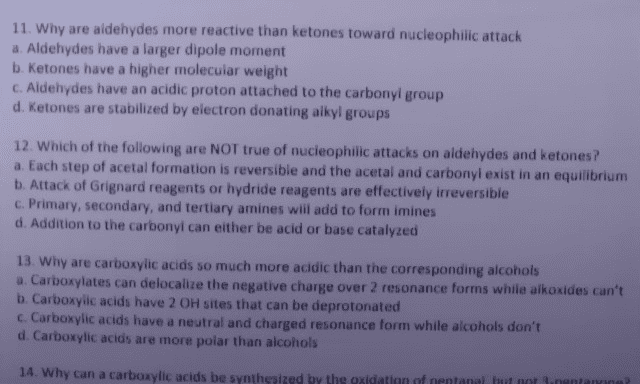CHEM 134 Lecture Notes - Lecture 20: Chloromethane, Organic Reactions, Methanol
42 views4 pages
16 Feb 2018
School
Department
Course
Professor
Document Summary
Except for formaldehyde, aldehydes have one h atom and one organic group bonded to a carbonyl group. Ketones have two organic groups bonded to a carbonyl group. Amines are derivatives of ammonia in which one or more h atoms have been replaced by organic groups (aliphatic or aromatic or a mixture of both). There are three classes of amines. Carboxylic acids contain the carboxyl functional group. The general formula for carboxylic acids is: R represents an alkyl or an aryl group. Iupac names for a carboxylic acid are derived from the name of the parent hydrocarbon. The final -e is dropped from the name of the parent hydrocarbon. The suffix -oic is added followed by the word acid. Many organic acids are called by their common (trivial) names which are derived from greek or latin. Five common types of organic reactions:
Get access
Grade+
$40 USD/m
Billed monthly

Homework Help
Study Guides
Textbook Solutions
Class Notes
Textbook Notes
Booster Class
10 Verified Answers
Class+
$30 USD/m
Billed monthly

Homework Help
Study Guides
Textbook Solutions
Class Notes
Textbook Notes
Booster Class
7 Verified Answers
Related textbook solutions
Chemistry: Structure and Properties
2 Edition,
Tro
ISBN: 9780134293936
Basic Chemistry
5 Edition,
Timberlake
ISBN: 9780134138046
Principles of Chemistry Molecular Approach
4th Edition,
Tro
ISBN: 9780134112831
Principles of Chemistry Molecular Approach
3rd Edition, 2014
Tro
ISBN: 9780321971944
Chemistry: Structure and Properties
2nd Edition,
Tro
ISBN: 9780134293936
Chemistry: A Molecular Approach
3rd Edition,
Tro
ISBN: 9780321809247
Chemistry: A Molecular Approach
5th Edition,
Tro
ISBN: 9780134874371
Principles of Chemistry: A Molecular Approach
4th Edition,
Tro
ISBN: 9780134895741
Chemistry: The Central Science
14th Edition, 2017
Brown
ISBN: 9780134414232



